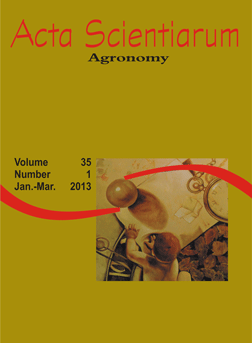<b>Cycle, canopy architecture and yield of common bean genotypes (<i>Phaseolus vulgaris</i>) in Santa Catarina State</b> - doi: 10.4025/actasciagron.v35i1.15516
Abstract
The objective of this study was to identify the phenotypic and genotypic correlations between the plant cycle and plant habit and the effect on yield in landrace bean genotypes. The experiment was conducted in Joaçaba and Lages, Santa Catarina State for the 2008/2009 crop using 26 bean genotypes: 22 landrace and 4 commercial genotypes obtained from the UDESC. We evaluated the number of days from emergence to flowering, number of days from flowering to physiological maturity and number of days from emergence to physiological maturity in relation to the genotypes’ cycle. The aerial plant architecture characteristics evaluated were the growth habit, plant habit, plant height, stem diameter, height of the first pod insertion and number of nodes on the main stem. Trail analysis showed that there was a positive correlation between the emergence-to-flowering period and yield and that the emergence-physiological maturity; flowering-physiological maturity showed a negative correlation to the yield in both locations. Therefore, short-cycle genotypes, especially those with a reduced post-flowering period, produced increased yields. The aerial plant architecture characteristics showed phenotypic and genotypic positive correlations with the yield in both environments. To increase yield, the reproductive period needs to coincide with periods of the greatest photosynthetically active radiation.
Downloads
DECLARATION OF ORIGINALITY AND COPYRIGHTS
I Declare that current article is original and has not been submitted for publication, in part or in whole, to any other national or international journal.
The copyrights belong exclusively to the authors. Published content is licensed under Creative Commons Attribution 4.0 (CC BY 4.0) guidelines, which allows sharing (copy and distribution of the material in any medium or format) and adaptation (remix, transform, and build upon the material) for any purpose, even commercially, under the terms of attribution.




















































